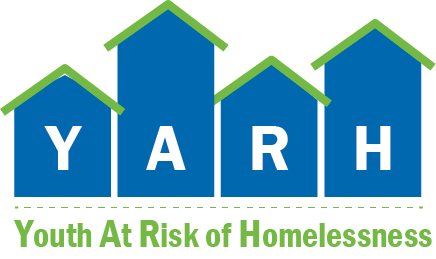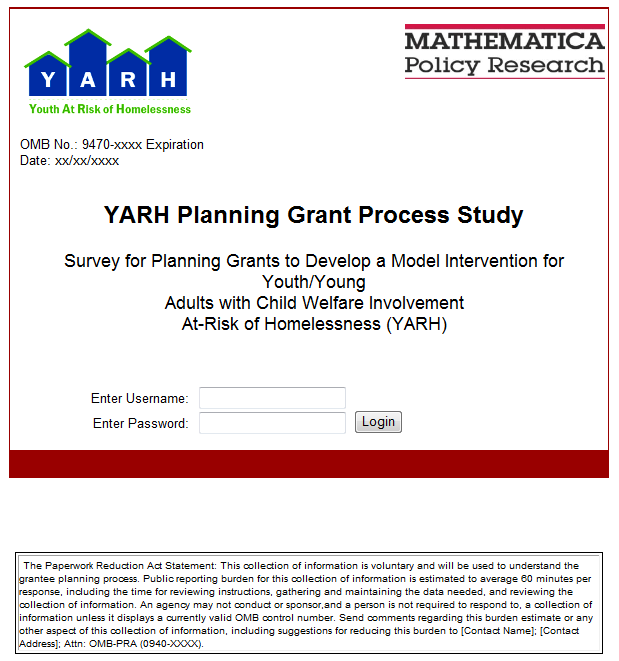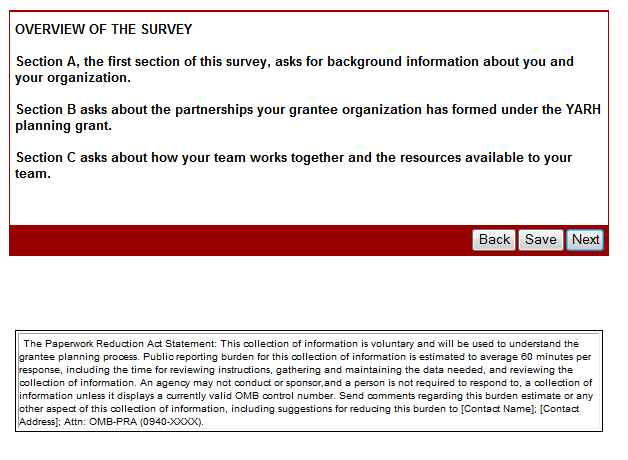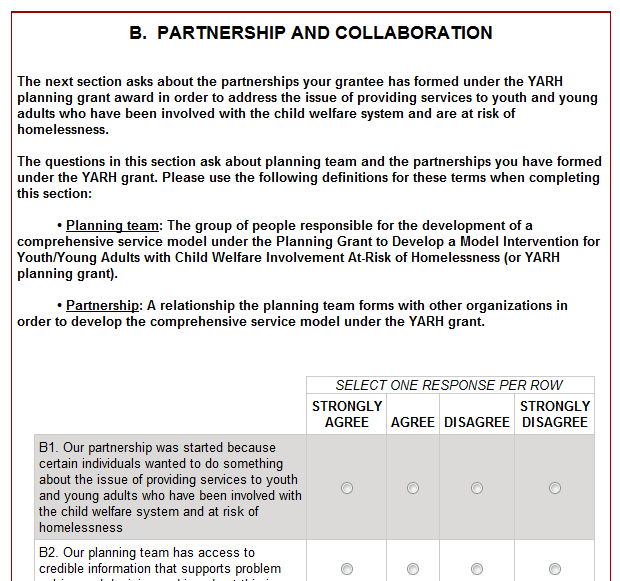Survey of Organizational Readiness and Partnership
Planning Grants to Develop a Model Intervention for Youth/Young Adults with Child Welfare Involvement At-Risk of Homelessness
Attachment 2_YARH Survey of Organizational Readiness and Partnership
Survey of Organizational Readiness and Partnership
OMB: 0970-0445
ATTACHMENT 2:
SURVEY OF ORGANIZATIONAL READINESS AND PARTNERSHIP
The Survey of Organizational Readiness and Partnership follows this cover page. The Planning Grants to Develop a Model Intervention for Youth/Young Adults with Child Welfare Involvement At-Risk of Homelessness (YARH) process study will administer the same survey at two points in time to members of the planning team and key partners who are not active members of the planning team.
The survey will be administered as a web-survey. Snapshots of sample pages are provided following the full instrument.


OMB No.: 0970-xxxx
Expiration Date: xx/xx/xxxx
YARH Planning Grant Process Study
Survey for Planning Grants to Develop a Model Intervention for Youth/Young Adults with Child Welfare Involvement
At-Risk of Homelessness (YARH)
Enter Username:
E
The
Paperwork Reduction Act Statement: This collection of information
is voluntary and will be used to understand the grantee planning
process. Public reporting burden for this collection of information
is estimated to average 60 minutes per response, including the time
for reviewing instructions, gathering and maintaining the data
needed, and reviewing the collection of information. An agency may
not conduct or sponsor, and a person is not required to respond to,
a collection of information unless it displays a currently valid
OMB control number. Send
comments regarding this burden estimate or any other aspect of this
collection of information, including suggestions for reducing this
burden, to [Contact Name]; [Contact Address]; Attn: OMB-PRA
(0970-XXXX).
OVERVIEW AND IMPORTANT INSTRUCTIONS
The Children’s Bureau and the Office of Planning, Research and Evaluation (OPRE) in the Administration for Children and Families (ACF) are seeking to improve the well-being of youth and young adults with child welfare involvement at risk of homelessness by developing comprehensive service models to improve the well-being of these youth.
Through the grant program Planning Grants to Develop a Model Intervention for Youth/Young Adults with Child Welfare Involvement At-Risk of Homelessness (YARH), the Children’s Bureau has provided planning grants to 18 new grantees nationwide. These grants are known as YARH planning grants. Grantees will use these resources to design a comprehensive service model that will support better outcomes for youth with child welfare involvement who are at risk of homelessness.
As part of this program, OPRE has contracted with Mathematica Policy Research to provide grantees with technical assistance and conduct a process study to better understand the planning process across sites.
You are being asked to complete this survey, which is part of the process study, because you were identified as a part of the planning team for [INSERT GRANTEE NAME]. Planning team members from grantee organizations are asked to complete this survey to provide crucial information about their organizations, relationships with partners and other collaborating organizations, and approaches to program planning.
Your participation in this survey is very important and will help us understand more about the grantee organizations and partners implementing planning programs funded under this award.
The survey should take about one hour to complete. Your responses will be kept private to the extent provided by law and used only for research purposes. They will be combined with the responses of other planning team members and administrators from key community partners and reported in the aggregate. No individual names will be reported. Participation in the survey is completely voluntary and you may choose to skip any question.
If you have any questions about the survey, please contact the team at Mathematica by emailing [email protected] or calling xxx-xxx-xxxx (toll-free). If you have any questions about your rights as a research participant, please contact the New England Institutional Review Board (IRB) at (800) 232 - 9570.
Thank you for participating in this survey. By completing this survey and submitting your responses, you are confirming that you understand that the information you provide will be kept private, used only for research purposes, and that your answers will be combined with other responses so that no individuals are identified. Please print a copy of this screen for your future reference.
OVERVIEW OF THE SURVEY
Section A, the first section of this survey, asks for background information about you and your organization.
Section B asks about the partnerships your grantee organization has formed under the YARH planning grant.
Section C asks about how your team works together and the resources available to your team.

A1. What is your gender?
1 Male
2 Female
A2. What is your birth year?
| | | | | year
A3. Are you Hispanic or Latino?
1 Yes
0 No
A4. What is your race?
MARK all that apply
1 American Indian/Alaska Native
2 Asian
3 Native Hawaiian or other Pacific Islander
4 Black or African American
5 White
A5. What is the highest level of education you have completed?
MARK ONE ONLY
1 No high school diploma or GED
2 High school diploma or GED
3 Some college, but no degree
4 Associate’s degree
5 Bachelor’s degree
6 Master’s degree or professional degree
7 Doctoral degree or equivalent
8 Other (specify)
A6. Which of the following describes the primary focus of your organization?
MARK all that apply
1 Child welfare
2 Mental health/substance abuse
3 Behavioral health
4 Education
5 Vocational training/rehabilitation
6 Criminal justice
7 Social work
8 Administration
9 Law enforcement
10 Medicine
11 Research and evaluation
12 Housing
13 Other (specify)
A7. Which of the following describes your educational background?
MARK all that apply
1 Child welfare
2 Mental health/substance abuse
3 Behavioral health
4 Education
5 Vocational training/rehabilitation
6 Criminal justice
7 Social work
8 Administration
9 Law enforcement
10 Medicine
11 Research and evaluation
12 Housing
13 Other (specify)
A8. Which of the following describes your role in your organization?
MARK ONE ONLY
1 Staff (case manager/direct service provider/member of a unit)
2 Supervisor of case workers/direct service providers
3 Manager of supervisor/unit
4 Administration (director, CEO, etc)
5 Evaluator or researcher
6 Other (specify)
A9. How many years of experience do you have in providing services to, managing services for, or developing policy for youth or young adults with child welfare involvement?
MARK ONE ONLY
1 A year or less
2 More than a year
3 More than 5 years
4 More than 10 years
A10. For how many years have you been employed by your current organization?
MARK ONE ONLY
1 A year or less
2 More than a year
3 More than 5 years
4 More than 10 years
The next two questions ask about the planning team you have formed under the YARH grant. Please use the following definitions for these terms when completing this section:
Planning team: The group of people responsible for the development of a comprehensive service model under the Planning Grant to Develop a Model Intervention for Youth/Young Adults with Child Welfare Involvement At-Risk of Homelessness (or YARH planning grant).
A11. Prior to its involvement with the YARH planning grant, did your organization ever…
|
SELECT ONE RESPONSE PER ROW |
|
|
YES |
NO |
a. Participate in partnerships or collaborations with any members of this planning team? |
1 |
0 |
b. Implement an evidence-based program or practice? |
1 |
0 |
c. Consider participating in a rigorous evaluation of a program (for example, using random assignment or a comparison group)? |
1 |
0 |
d. Participate in or conduct a rigorous evaluation of a program (for example, using random assignment or a comparison group)? |
1 |
0 |
A12. Prior to your involvement with the YARH planning grant, did you personally ever…
|
SELECT ONE RESPONSE PER ROW |
|
|
YES |
NO |
a. Participate in partnerships or collaborations with any members of this planning team? |
1 |
0 |
b. Implement an evidence-based program or practice? |
1 |
0 |
c. Participate in or conduct a rigorous evaluation of a program (for example, using random assignment or a comparison group)? |
1 |
0 |
A13. How has your organization participated in the YARH planning grant?
|
SELECT ONE RESPONSE PER ROW |
|
|
YES |
NO |
a. Joint planning? |
1 |
0 |
b. Shared funding? |
1 |
0 |
c. Shared staff? |
1 |
0 |

The next section asks about the partnerships formed under the YARH planning grant award in order to address the issue of providing services to youth and young adults who have been involved with the child welfare system and are at risk of homelessness.
The questions in this section ask about the planning team and the partnerships you have formed under the YARH grant. Please use the following definitions for these terms when completing this section:
Planning team: The group of people responsible for the development of a comprehensive service model under the Planning Grant to Develop a Model Intervention for Youth/Young Adults with Child Welfare Involvement At-Risk of Homelessness (or YARH planning grant).
Partnership: A relationship the planning team forms with other organizations in order to develop the comprehensive service model under the YARH grant.
|
SELECT ONE RESPONSE PER ROW |
|||
|
STRONGLY AGREE |
AGREE |
DISAGREE |
STRONGLY DISAGREE |
B1. Our partnership was started because certain individuals wanted to do something to help youth and young adults who have been involved with the child welfare system and are at risk of homelessness. |
1 |
2 |
3 |
4 |
B2. Our planning team has access to credible information that supports problem solving and decision making about this issue. |
1 |
2 |
3 |
4 |
B3. The membership of our planning team includes those stakeholders affected by the issue. |
1 |
2 |
3 |
4 |
B4. Our planning team is not dominated by any one group or sector. |
1 |
2 |
3 |
4 |
B5. Stakeholders have agreed to work together on this issue. |
1 |
2 |
3 |
4 |
B6. Stakeholders have agreed on what decisions will be made by the planning team. |
1 |
2 |
3 |
4 |
B7. Our planning team has set ground rules and norms about how we will work together. |
1 |
2 |
3 |
4 |
B8. We have a method for communicating the activities and decisions of the planning team to all members. |
1 |
2 |
3 |
4 |
B9. There are clearly defined roles for planning team members. |
1 |
2 |
3 |
4 |
B10. Members are more interested in getting a good group decision than in improving the position of their home organization. |
1 |
2 |
3 |
4 |
B11. Members are willing to let go of an idea for one that appears to have more merit. |
1 |
2 |
3 |
4 |
B12. Members are effective liaisons between their home organizations and the group. |
1 |
2 |
3 |
4 |
B13. Members are willing to devote whatever effort is necessary to achieve the planning team’s goals. |
1 |
2 |
3 |
4 |
B14. Members trust each other sufficiently to honestly and accurately share information, perceptions, and feedback |
1 |
2 |
3 |
4 |
B15. Divergent opinions are expressed. |
1 |
2 |
3 |
4 |
B16. Divergent opinions are listened to. |
1 |
2 |
3 |
4 |
B17. The planning team has an effective decision-making process. |
1 |
2 |
3 |
4 |
B18. The openness and credibility of the process help members set aside doubts or skepticism. |
1 |
2 |
3 |
4 |
B19. Planning team members set aside vested interests to achieve our common goal. |
1 |
2 |
3 |
4 |
B20. Our planning team is effective in obtaining the resources it needs to accomplish its objectives. |
1 |
2 |
3 |
4 |
B21. The time and effort of the partnership are directed at obtaining the goals rather than keeping the partnership in business. |
1 |
2 |
3 |
4 |

C1. Please think about the people that are participants in your planning team (“team”). By working together, how well is the team able to do each of the following?
|
SELECT ONE RESPONSE PER ROW |
||||
|
EXTREMELY WELL |
VERY WELL |
SOMEWHAT WELL |
NOT SO WELL |
NOT AT ALL WELL |
a. Identify new and creative ways to solve problems |
1 |
2 |
3 |
4 |
5 |
b. Include the views and priorities of people on the team |
1 |
2 |
3 |
4 |
5 |
c. Develop goals that are widely understood and supported among team members |
1 |
2 |
3 |
4 |
5 |
d. Problem solve and/or address issues facing the community |
1 |
2 |
3 |
4 |
5 |
e. Obtain support from the central office and organizations in the community that can either block the team’s plans or help move them forward |
1 |
2 |
3 |
4 |
5 |
f. Carry out comprehensive activities that connect multiple services, programs, or systems |
1 |
2 |
3 |
4 |
5 |
C2. How effective is your team’s leadership in each of the following areas?
|
SELECT ONE RESPONSE PER ROW |
|||||
|
EXCELLENT |
VERY GOOD |
GOOD |
FAIR |
POOR |
DON’T KNOW |
a. Taking responsibility for the team |
1 |
2 |
3 |
4 |
5 |
d |
b. Inspiring or motivating people involved in the team |
1 |
2 |
3 |
4 |
5 |
d |
c. Empowering people involved in the team |
1 |
2 |
3 |
4 |
5 |
d |
d. Communicating the vision of the team |
1 |
2 |
3 |
4 |
5 |
d |
e. Working to develop a common language within the team |
1 |
2 |
3 |
4 |
5 |
d |
f. Fostering respect, trust, inclusiveness, and openness in the team |
1 |
2 |
3 |
4 |
5 |
d |
g. Creating an environment where differences can be voiced |
1 |
2 |
3 |
4 |
5 |
d |
h. Resolving conflict among the team members |
1 |
2 |
3 |
4 |
5 |
d |
i. Combining the perspectives, resources, and skills of the team |
1 |
2 |
3 |
4 |
5 |
d |
j. Helping the team be creative and look at things differently |
1 |
2 |
3 |
4 |
5 |
d |
C3. How well does your team use staffing resources?
MARK ONE ONLY
1 The team makes excellent use of staffing resources
2 The team makes very good use of staffing resources
3 The team makes good use of staffing resources
4 The team makes fair use of staffing resources
5 The team makes poor use of staffing resources
C4. How well does your team use in-kind resources (e.g., skills, expertise, information, data, connections, influence, space, equipment, goods)?
MARK ONE ONLY
1 The team makes excellent use of in-kind resources
2 The team makes very good use of in-kind resources
3 The team makes good use of in-kind resources
4 The team makes fair use of in-kind resources
5 The team makes poor use of in-kind resources
C5. How well does your team use its time?
MARK ONE ONLY
1 The team makes excellent use of time
2 The team makes very good use of time
3 The team makes good use of time
4 The team makes fair use of time
5 The team makes poor use of time
Now, we would like you to think about the administrative and management activities in your team.
C6. How effective is your team in each of the following activities?
|
SELECT ONE RESPONSE PER ROW |
|||||
|
EXCELLENT |
VERY GOOD |
GOOD |
FAIR |
POOR |
DON’T KNOW |
a. Coordinating communication among the team |
1 |
2 |
3 |
4 |
5 |
d |
b. Coordinating communication with staff and organizations outside the team |
1 |
2 |
3 |
4 |
5 |
d |
c. Organizing team activities, including meetings and projects |
1 |
2 |
3 |
4 |
5 |
d |
d. Managing flex funds and area office resources (i.e., contracted slots for service, beds, etc.) |
1 |
2 |
3 |
4 |
5 |
d |
e. Evaluating the progress and impact of the team |
1 |
2 |
3 |
4 |
5 |
d |
A team needs non-financial resources in order to work effectively and achieve its goals. For each of the following types of resources, to what extent does your team have what it needs to work effectively?
|
SELECT ONE RESPONSE PER ROW |
|||||
|
ALL OF WHAT IT NEEDS |
MOST OF WHAT IT NEEDS |
SOME OF WHAT IT NEEDS |
ALMOST NONE OF WHAT IT NEEDS |
NONE OF WHAT IT NEEDS |
DON’T KNOW |
C7. Skills and expertise (e.g., leadership, administration, evaluation, law, public policy, cultural competency, training, community organizing) |
1 |
2 |
3 |
4 |
5 |
d |
C8. Data and information (e.g., statistical data, information about community perceptions, values, resources, and politics) |
1 |
2 |
3 |
4 |
5 |
d |
C9. Connections to target populations |
1 |
2 |
3 |
4 |
5 |
d |
C10. Connections to central office decision makers, other government agencies, other organizations/groups |
1 |
2 |
3 |
4 |
5 |
d |
C11. Legitimacy and credibility |
1 |
2 |
3 |
4 |
5 |
d |
C12. Influence and ability to bring team members together for meetings and activities |
1 |
2 |
3 |
4 |
5 |
d |
A team also needs financial and other capital resources in order to work effectively and achieve its goals. For each of the following types of resources, to what extent does your team have what it needs to work effectively?
|
SELECT ONE RESPONSE PER ROW |
|||||
|
ALL OF WHAT IT NEEDS |
MOST OF WHAT IT NEEDS |
SOME OF WHAT IT NEEDS |
ALMOST NONE OF WHAT IT NEEDS |
NONE OF WHAT IT NEEDS |
DON’T KNOW |
C13. Money (budgeted support) |
1 |
2 |
3 |
4 |
5 |
d |
C14. Space (for which the team is responsible) |
1 |
2 |
3 |
4 |
5 |
d |
C15. Equipment and goods (for which the team is responsible) |
1 |
2 |
3 |
4 |
5 |
d |
C16. How comfortable are you with the way decisions are made by the team?
MARK ONE ONLY
1 Extremely comfortable
2 Very comfortable
3 Somewhat comfortable
4 A little comfortable
5 Not at all comfortable
C17. How often do you support decisions made by the team?
MARK ONE ONLY
1 All of the time
2 Most of the time
3 Some of the time
4 Almost none of the time
5 None of the time
C18. How often do you feel that you have been left out of the decision-making process?
MARK ONE ONLY
1 All of the time
2 Most of the time
3 Some of the time
4 Almost none of the time
5 None of the time
C19. For each of the following benefits, please indicate whether you have or have not received the benefit as a result of participating in this team.
|
SELECT ONE RESPONSE PER ROW |
|
|
YES |
NO |
a. Development of valuable relationships |
1 |
0 |
b. Enhanced ability to meet the needs of your constituency or clients |
1 |
0 |
c. Ability to have a greater impact than you could have on your own |
1 |
0 |
d. Ability to make a contribution to the service system in your community |
1 |
0 |
e. Acquisition of additional financial support for the office to assist in service delivery |
1 |
0 |
f. Enhanced ability to address an important issue |
1 |
0 |
g. Development of new skills |
1 |
0 |
h. Heightened self-awareness in your role at your home organization |
1 |
0 |
i. Increased utilization of your expertise or services |
1 |
0 |
j. Acquisition of useful knowledge about services, programs, or people in the community |
1 |
0 |
k. Enhanced ability to affect public policy |
1 |
0 |
C20. For each of the following drawbacks, please indicate whether you have or have not experienced the drawback as a result of participating in this team.
|
SELECT ONE RESPONSE PER ROW |
|
|
YES |
NO |
a. Diversion of time and resources away from other priorities or obligations |
1 |
0 |
b. Insufficient influence in team activities |
1 |
0 |
c. Viewed negatively due to association with the team |
1 |
0 |
d. Frustration or aggravation |
1 |
0 |
e. Insufficient credit given for contributing to the accomplishments of the team |
1 |
0 |
f. Conflict between your job and the team’s work |
1 |
0 |
C21. So far, how have the benefits of participating in this team compared to the drawbacks?
MARK ONE ONLY
1 Benefits greatly exceed drawbacks
2 Benefits exceed the drawbacks
3 Benefits and drawbacks are about equal
4 Drawbacks exceed the benefits
5 Drawbacks greatly exceed the benefits
C22. How satisfied are you with the following aspects of your team?
|
SELECT ONE RESPONSE PER ROW |
||||
|
COMPLETELY SATISFIED |
MOSTLY SATISFIED |
SOMEWHAT SATISFIED |
A LITTLE SATISFIED |
NOT AT ALL SATISFIED |
a. The way people on the team work together |
1 |
2 |
3 |
4 |
5 |
b. Your influence in the team |
1 |
2 |
3 |
4 |
5 |
c. Your role in the team |
1 |
2 |
3 |
4 |
5 |
d. The team’s plans for achieving its goals |
1 |
2 |
3 |
4 |
5 |
e. The way the team is implementing its phase |
1 |
2 |
3 |
4 |
5 |
Thank you for your participation in this survey! Your responses will help us understand the experiences of organizations during the YARH grant planning phase. Please submit your responses today.





| File Type | application/vnd.openxmlformats-officedocument.wordprocessingml.document |
| File Title | YARH SURVEY OF ORGANIZATIONAL READINESS AND PARTNERSHIP |
| Subject | SAQ |
| Author | Mathematica Staff |
| File Modified | 0000-00-00 |
| File Created | 2021-01-26 |
© 2025 OMB.report | Privacy Policy